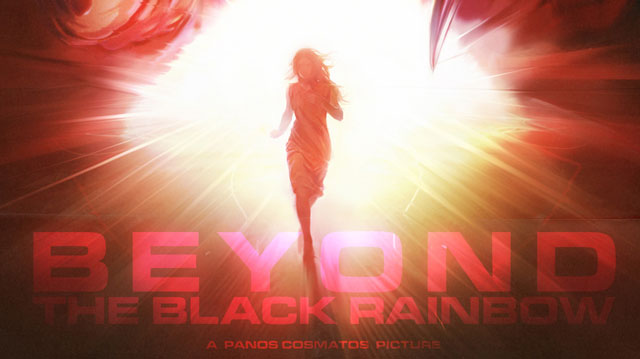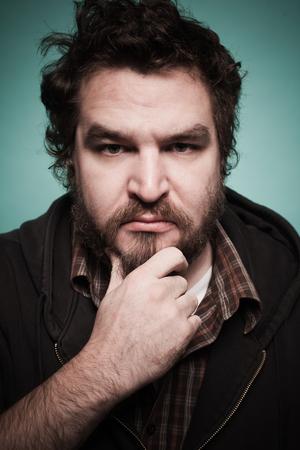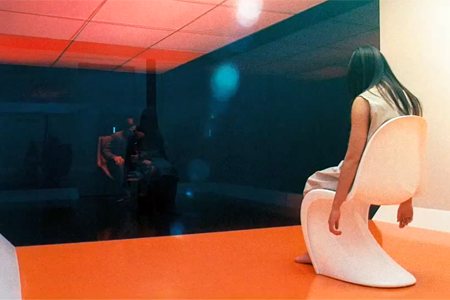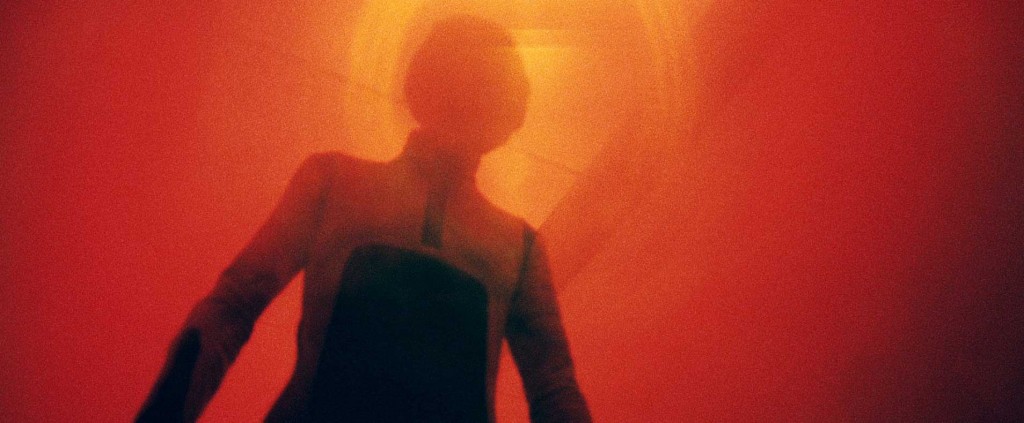
Over the past year and half, Beyond the Black Rainbow has become the most love it or hate it film of the festival circuit. Some decry it as boring film-school-wank, while an ever-growing contingent hail it as a mind-melting work of whacked-out brilliance. But both its detractors and its champions would likely agree there really isn’t another movie out there quite like Beyond the Black Rainbow. It is a singular work. Its images and soundtrack will beset your mind long after you’ve seen it. And like the most interesting cinema should be, it is a film that you will want to see just so you can weigh in on the debate. It is the work of first-time Canadian filmmaker Panos Cosmatos, son of late action cinema director George P. Cosmatos (Rambo: First Blood Part II, Tombstone).
Set in 1983, Black Rainbow takes place within the walls of the Arboria Institute, where a beautiful girl (Eva Allan) is held captive by a deranged scientist, Dr. Barry Nyle (Michael Rogers). Her mind seems to be controlled and influenced by a mysterious diamond-shaped light kept in a secret room. Eventually, the girl must try and escape from Arboria and Dr. Nyle.
Josh: This film has the feeling of coming from some alternate reality. But you live in Canada, which is hardly an alternate reality. Tell me a bit about your background.
Cosmatos: I was born in Rome. My mom was an experimental sculptor; she passed away 1997. My dad was a moviemaker; made mostly Hollywood movies. We lived all over the place when I was a kid — Sweden, Greece, London, Mexico. Then eventually we moved to Canada. In retrospect, I was just thinking about this the other day, I think my mother wanted to raise me someplace more like Sweden, but we also wanted to be close to LA. We basically lived in the suburbs. And that’s when I got really immersed in pop culture from America, whereas in London or Sweden it was a little bit more [European.] But once we got to Canada it was like — I remember being in a hotel, turning on the TV, and it happened to be a Saturday morning, and it was Saturday morning cartoons! I’d never seen anything like that before in my life. It was every comic book that I liked with cool animation. I couldn’t believe it.
Josh: What was the germ of Beyond the Black Rainbow? Did it come from a concept, or an image you had in your mind?
 Cosmatos: In the mid-90’s I started thinking about this idea I wanted to do of a girl who is institutionalized, and this doctor that was trying to control her. That version was a lot different; it changed over the years. I just streamlined it as it merged with my visual obsessions. When I started to write scripts, I was trying to figure out what kind of films I wanted to make. At that time I was watching a lot of European films, because I hadn’t discovered that end of cinema much yet. There was this video store I went to called Pick A Flick that had the biggest selection of European films, and I just started going through that tape by tape, watching every European art film from the 60’s and 70’s. After my dad died [George Cosmatos passed in 2005] I reconnected with pop culture, with all the films I loved in my youth. And then I had this idea [inspired by] these storefronts you’d see around town, that were basically just a table with some pamphlets on it and a person sitting there — a religious thing. I wanted to open one of those and create a fake religion around it, to see what would happen.
Cosmatos: In the mid-90’s I started thinking about this idea I wanted to do of a girl who is institutionalized, and this doctor that was trying to control her. That version was a lot different; it changed over the years. I just streamlined it as it merged with my visual obsessions. When I started to write scripts, I was trying to figure out what kind of films I wanted to make. At that time I was watching a lot of European films, because I hadn’t discovered that end of cinema much yet. There was this video store I went to called Pick A Flick that had the biggest selection of European films, and I just started going through that tape by tape, watching every European art film from the 60’s and 70’s. After my dad died [George Cosmatos passed in 2005] I reconnected with pop culture, with all the films I loved in my youth. And then I had this idea [inspired by] these storefronts you’d see around town, that were basically just a table with some pamphlets on it and a person sitting there — a religious thing. I wanted to open one of those and create a fake religion around it, to see what would happen.
I laugh.
Cosmatos: Then I realized I should just take these disparate elements and put them towards this movie idea. It clicked and fit together, and that’s when I started working on the movie as it is now.
Josh: Did you decide to set the film in the early 80’s so you could facilitate the visual style you saw in your mind?
Cosmatos: That was definitely the first part of it. Then I settled upon the year because I decided to work in the cult element. It organically grew that it originated in the 60’s, so 1983 just fit the age of the characters.
Josh: It sounds like there were a lot of things that influenced you leading up to the project. What films in particular really inspired Black Rainbow?
Cosmatos: I’d say [Saul Bass’s] Phase IV. And the blue, what we called “night mode,” was the from the freezer room in John Carpenter’s Dark Star. The overall general look was definitely inspired by Phase IV, and in some ways Heat by Michael Mann.
Josh: Heat? That’s not one I expected to hear.
Cosmatos: I’m a really big fan of Mann’s sort of modernists oblique framing that he likes to use. And the flashbacks [in Black Rainbow], the black and white look, was inspired by [E. Elias Merhige’s] The Begotten. Because it looked like an artifact from a dream. I really wanted the 60’s flashbacks to have that feeling of an artifact from the past. Though the acid trip within the flashback I drew from the film-within-a-film in [Jean-Luc Godard’s] Contempt. I liked presenting something sort of undefinable.

Josh: Your film is so imagery-based, with ultimately only a smattering of dialogue. I’m curious, what did the script look like? How long was it?
Cosmatos: The script was 86 pages long. At the screening at Tribeca I made a joke when someone in the audience asked me how long the script was, and I said “11 pages.” And then later I read a review where they said the script was 11 pages long! (laughs) But it was 86! After I made that joke I even said “just kidding.”
Josh: Well, we can set the record straight on that issue right here.
Cosmatos: The script was extremely descriptive. I’d never shot a movie before, and I think I went overboard because I was dealing with stuff that was so abstract. So I was very descriptive in trying to get across what was going to be on screen.
Josh: When you set out to make this film, what sort of reaction where you hoping to get from audiences?
Cosmatos: The whole time [we were in production] I was really just trying to push myself to make the movie that I wanted to see and not compromise. And I was so immersed in doing that, that I completely stopped thinking about what other people would think. And then when it was done, and there it was, I watched it and thought to myself, “I don’t even know what it is that I have made.” (laughs) I did exactly what I wanted to do, and now it actually exists and is a completed thing. For a while there I had no idea what I’d created. Though that made me happy. I liked that I couldn’t fit it into a genre in my own mind. I felt like I’d succeeded somehow. I had no idea how people would react to it. And initially the reaction was pretty negative to lukewarm. But I remember the very first screening in Italy, there were some people in the audience that were younger that really responded to it. And that made me happy. At that point I figured if I was lucky I would have a movie that would have a very small cult following. And that’s all you can really hope for.
Josh: I’m also curious about the music. I sensed a little John Carpenter flavor in there.
Cosmatos: I wanted it to have a grindy synthesizer score, that didn’t feel it too clean. Then I was lucky to meet Jeremy Schmidt from the Sinoia Caves. He has this massive record collection of the 60’s through the 80’s. He shares a very similar sensibility. And I gave him some direction of what I wanted for certain sequences, but for the most part I just gave him general feelings and ideas of what I wanted and let him do whatever he wanted. It was a pleasure to let him create stuff for the film.
Josh: This is a very small budget film. But you achieved a completely whole vision. Like on a big budget film, I felt like I couldn’t see the “seams,” if you will. How did you approach the sets and scenes with your camera? Can you talk about any framing tricks you used?
Cosmatos: (laughing) Framing tricks!
Josh: I meant that in a good way!
Cosmatos: No, no, hilarious, I love it! I was just very diligent about not showing anything that didn’t look good. I once read in a film book – I can’t remember where, I wish I could – but it said that it is as important what you don’t show as it is what you do show. And I took that to heart very early on. In my first short film I would just go to these locations and look for things that looked right, and then just frame out everything else. It’s obvious, but some of these things stick in your mind. I used that same approach in this as I did in that first super 8 short film. I wanted the movie to have a claustrophobic feeling to it, so that formality worked in its favor. Obviously in a low budget film you can’t go wide as much as you’d like sometimes.
Josh: Though a couple sets were extremely impressive. I’m guessing they were real locations. What about the arboretum? That was particularly interesting looking. Was that a real place?
Costamtos: Yeah, that was real location. No way we could have afforded to build that. We were just lucky enough to find that in Vancouver. It was incredibly cheap to film there too. Only cost a couple hundreds bucks to film there for the night!
Josh: I can dig it.
